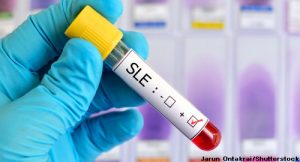 Although systemic lupus erythematosus (SLE) has an unpredictable disease course, rheumatologists recognize that persistent disease activity and flares may predict joint and organ damage and mortality.
Although systemic lupus erythematosus (SLE) has an unpredictable disease course, rheumatologists recognize that persistent disease activity and flares may predict joint and organ damage and mortality.
Ominosity
A 2021 study found a score of 20 or more on the 2019 EULAR/ACR SLE Classification Criteria can predict ominosity—or the likelihood of a more severe disease course—in patients with SLE. Senior investigator Sindhu R. Johnson, MD, PhD, associate professor in the Division of Rheumatology, University of Toronto, Canada, was co-chair of the 12-member 2019 EULAR/ACR SLE Classification Criteria steering committee.
In the study, Dr. Johnson and her colleagues sought to determine the possible link between the new EULAR/ACR SLE scores at diagnosis and subsequent disease severity. They found patients with a score of 20 or more had a more active disease course throughout the first five years than did those with a score less than 20 (P<0.001). Their findings were published in the Annals of the Rheumatic Diseases, and the researchers concluded the new criteria provide prognostic information about the severity of lupus in the first five years after diagnosis.3
New Tool for Patient Stratification
“There are no special tools or up-front methods to determine which population will have a worse disease course,” says first author Laura P. Whittall Garcia, MD, a clinical research fellow studying SLE at Toronto Western Hospital.
According to Dr. Garcia, although rheumatologists recognize that patients with lupus nephritis may have a worse disease course than those without nephritis, the new results are surprising because they apply to patients without lupus nephritis. All patients with an EULAR/ACR SLE score of 20 or more had a more ominous disease course than those with a score of less than 20. Dr. Johnson adds their findings indicate that these classification criteria both classify and prognosticate, suggesting they may be a new tool for patient stratification. She believes the criteria can help rheumatologists know which patients should be more closely followed in clinical practice.
The study involved an inception cohort of 875 patients, and the researchers followed 86.6% for at least one year, 76% for three years and 65.6% for five years. When the researchers applied the 2019 EULAR/ACR SLE Classification Criteria, they found, at diagnosis, 1.8% had a score of less than 10 and approximately half had a score of 20 or more. The scores had a normal distribution curve over a mean of 20.5. The three most common clinical domains of the EULAR/ACR SLE criteria documented in the study cohort were joint involvement, acute cutaneous lupus and non-scarring alopecia.
Using these data, the investigators calculated that a EULAR/ACR SLE score of 20 was optimal for use as a threshold to compare demographic, clinical characteristics and outcomes between groups.
The team then applied that threshold and analyzed the data. At baseline, patients who presented with a score higher than 20 were younger than those who had lower scores (34.5 vs. 38.1 years old; P≤0.001), and they had a higher SLE Disease Activity Index 2000 (SLEDAI-2K) score than those who had lower EULAR/ACR SLE scores. When the researchers analyzed cumulative medication doses, they found patients with a EULAR/ACR SLE score of 20 or more required more aggressive therapy with glucocorticoids and immunosuppressive therapy than those who had a score of less than 20. Specifically, patients with a score of 20 or more had greater cumulative and mean daily doses of glucocorticoids during the first one, three and five years of disease course than those who had a score of less than 20.
Beyond Lupus Nephritis
Patients with a EULAR/ACR SLE score of 20 or more had greater number of organ system involvements than did patients with a score of less than 20. The exceptions to this finding were autoimmune hemolysis, psychosis, subacute cutaneous and discoid rash, which were evenly distributed between groups. Additionally, the investigators found patients with a EULAR/ACR SLE score of 20 or more had higher adjusted mean SLE Disease Activity Index 2000 scores over the first one, three and five years than did patients with a score less than 20. At baseline, age also correlated with SLE Disease Activity Index 2000 at three and five years.
Dr. Johnson expressed surprise that the study revealed patients with a EULAR/ACR SLE score of 20 or more were more likely to present with flares than those with a score of less than 20 (P<0.001), in general, and renal and hematological flares, specifically. After adjusting for ethnicity and age at baseline, the researchers found that every 10-point increase in EULAR/ACR SLE score increased the risk of a flare by 22.5%. However, the authors did not find a correlation between EULAR/ACR SLE score at baseline and damage at five years after diagnosis.
The investigators considered four different definitions of remission: 1) complete remission (i.e., no clinical and serological disease activity as determined by SLEDAI-2K score=0) off treatment, 2) clinical remission (i.e., serologically active clinical quiescent disease described as clinical SLEDAI-2K score=0, high anti-dsDNA antibodies and/or declining C3 level) off treatment, 3) complete remission on treatment and 4) clinical remission on treatment. They found that, during any given timeframe, patients with a EULAR/ACR SLE score of 20 or more were less likely to achieve remission than those with a score less than 20. Individuals with a score of 20 or more had at least a 15% lower probability of achieving remission than individuals with a score of less than 20.
When the researchers analyzed the subgroup of patients without lupus nephritis, they again found those with a EULAR/ACR SLE score of 20 or more had a higher SLE Disease Activity Index 2000 throughout the first five years, as well as a lower probability of achieving remission—for all definitions of remission described above, except for clinical remission on treatment—than did patients with a score of less than 20.
Dr. Garcia wants her rheumatologist colleagues to know the study findings suggest that if a patient is diagnosed with a multisystem disease—even in the absence of nephritis—they have a higher probability of a more active clinical course following the first five years of diagnosis than do patients without multisystem disease.
However, Dr. Johnson emphasizes the criteria have been endorsed only for classification—not for predictions of ominosity.
Lara C. Pullen, PhD, is a medical writer based in the Chicago area.
Reference
- Whittall Garcia LP, Gladman DD, Urowitz M, et al. New EULAR/ACR 2019 SLE classification criteria: Defining ominosity in SLE. Ann Rheum Dis. 2021;80:767–774.


